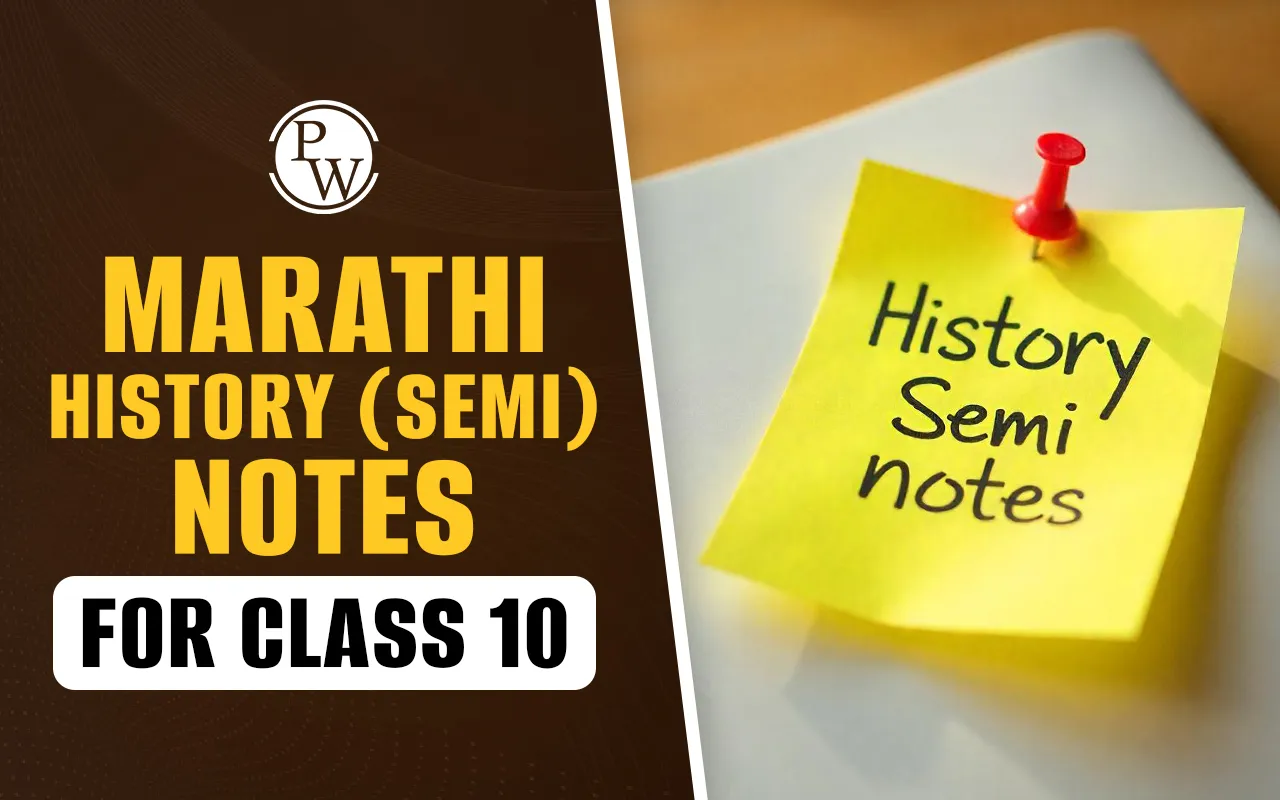
Marathi History (Semi) Notes for Class 10: Class 10 Marathi History (Semi) is an essential subject for SSC board students, focusing on Maharashtra’s rich historical and cultural heritage.
The syllabus includes topics like Indian freedom struggle, post-independence developments, and global events. Understanding the exam pattern is crucial—typically featuring objective questions, short notes, and long-answer type questions.
Practicing previous year papers helps students identify important topics and question trends, improving time management and accuracy. These notes offer a concise overview of key events, timelines, and important personalities, aiding in quick revision before exams. Scoring well requires conceptual clarity, regular revision, and solving sample and past papers effectively.
Marathi Geography(Semi) Notes for Class 10
Marathi History (Semi) Notes for Class 10 are important for SSC students as they cover key topics like Maharashtra’s heritage, freedom struggle, and global developments. These notes help in understanding the syllabus, exam pattern, and guide previous year papers.
Regular revision and solving practice papers boost exam readiness. For easy access to topic-wise resources, check the table below, which includes direct links to downloadable PDFs for many topics, making your preparation more efficient and structured.
|
Marathi History (Semi) Notes for Class 10 |
|
|
Topic |
|
|
इतिहासलेखन पाश्चात्त्य परंपरा |
|
|
इतिहासलेखन भारतीय परंपरा |
|
|
उपयोगित इतिहास |
|
|
भारतीय कलांचा इतिहास |
|
|
प्रसारमाध्यमे आणि इतिहास |
|
|
मनोरंजनाची माध्यमे आणि इतिहास |
|
|
खेळ आणि इतिहास |
|
|
पर्यटन आणि इतिहास |
|
|
ऐतिहासिक ठेव्यांचे जतन |
|
Also Check: Marathi History (EM) Notes for Class 10
Here is a detailed overview of each topic from the Marathi History (Semi) Class 10 notes based on the table:
1. इतिहासलेखन पाश्चात्त्य परंपरा
This chapter explains how Western historians approach history writing, emphasizing scientific methods and objectivity. It introduces the contributions of historians like Herodotus and Leopold von Ranke. Students learn the difference between ancient and modern historical narratives.
2. इतिहासलेखन भारतीय परंपरा
This chapter focuses on the Indian traditions of recording history, including mythological, religious, and literary sources. It highlights the role of ancient texts like the Vedas, Puranas, and epics and emphasizes how historical documentation evolved over time in India.
3. उपयोगित इतिहास
Covers the practical applications of history in modern times. Students understand how historical knowledge helps in administration, tourism, policy-making, and heritage conservation. It also explains the importance of applying historical insights to solve contemporary problems.
4. भारतीय कलांचा इतिहास
Explores the rich legacy of Indian art forms including architecture, sculpture, painting, and performing arts. The chapter links art development with historical periods like the Maurya and Gupta eras. It helps students appreciate India's artistic achievements through ages.
5. प्रसारमाध्यमे आणि इतिहास
Discusses the influence of mass media like newspapers, radio, and television in preserving and communicating history. It covers how media plays a key role in shaping public perception about historical events and national identity.
6. मनोरंजनाची माध्यमे आणि इतिहास
Focuses on entertainment forms such as drama, cinema, and music and their historical significance. It explains how these mediums evolved over time and how they reflect cultural, political, and social changes in society.
7. खेळ आणि इतिहास
Describes the evolution of sports in India and their connection to history. It highlights traditional Indian games and the introduction of modern sports during the British era. The chapter also touches on how sports promote national unity and identity.
8. पर्यटन आणि इतिहास
Explains how tourism helps in preserving historical monuments and spreading awareness about cultural heritage. The chapter covers famous historical tourist destinations in Maharashtra and their economic importance.
9. ऐतिहासिक ठेव्यांचे जतन
Stresses the need to preserve historical artifacts, monuments, and manuscripts. It educates students about the role of institutions like museums and archives in conservation. The chapter also introduces the idea of heritage management.
Also Check: Marathi Geography(EM) Notes for Class 10
Below, we have provided some of the benefits of Marathi class 10 history notes -
1. Easy Understanding of Concepts
The notes simplify complex historical topics into easy-to-understand language, making it easier for students to grasp important ideas without confusion.
2. Quick Revision Tool
They are ideal for last-minute revision before exams, offering concise summaries of each chapter, key points, dates, and events.
3. Aligned with Exam Pattern
These notes are prepared as per the latest SSC board syllabus and exam pattern, helping students focus on what’s most likely to be asked in exams.
4. Time-Saving Resource
Students don’t need to read entire textbooks repeatedly. The notes offer a filtered and focused version of the content, saving valuable study time.
5. Boosts Confidence and Scores
By revising regularly from these notes and solving related questions, students feel more confident and are better prepared to score high marks.
6. Helps in Solving Previous Year Papers
The notes cover important questions and frequently repeated topics, which are useful while practicing previous year question papers.
7. Topic-Wise PDF Access
Students can directly access individual chapters in PDF format, making it easy to study on phone, tablet, or print them out when needed.
| Links Related to MHT CET 2025 | |
| MHT CET 2025 | MHT CET Apply Online |
| MHT CET Syllabus | MHT CET Eligibility Criteria |
| MHT CET Previous Year Question Papers | |
